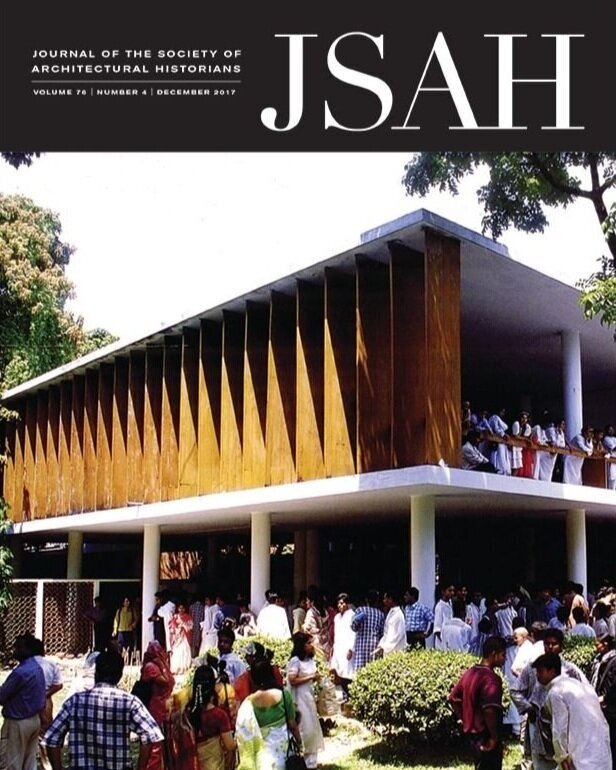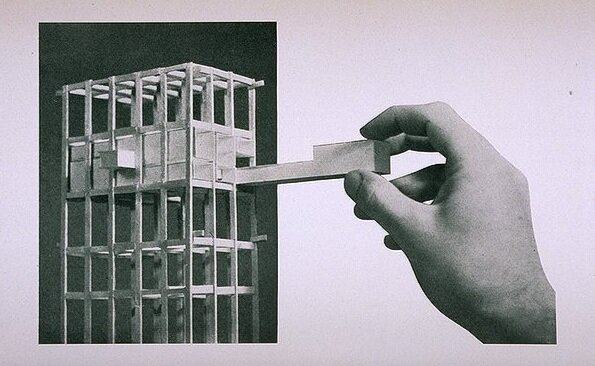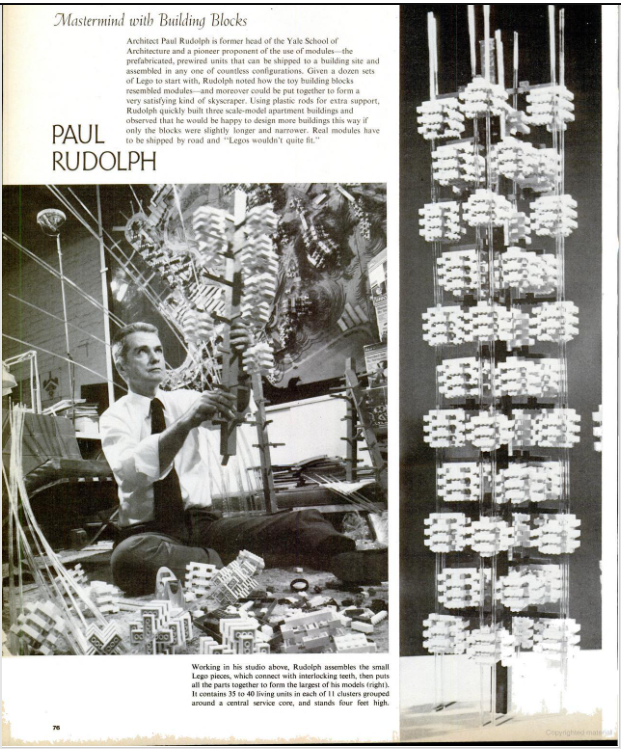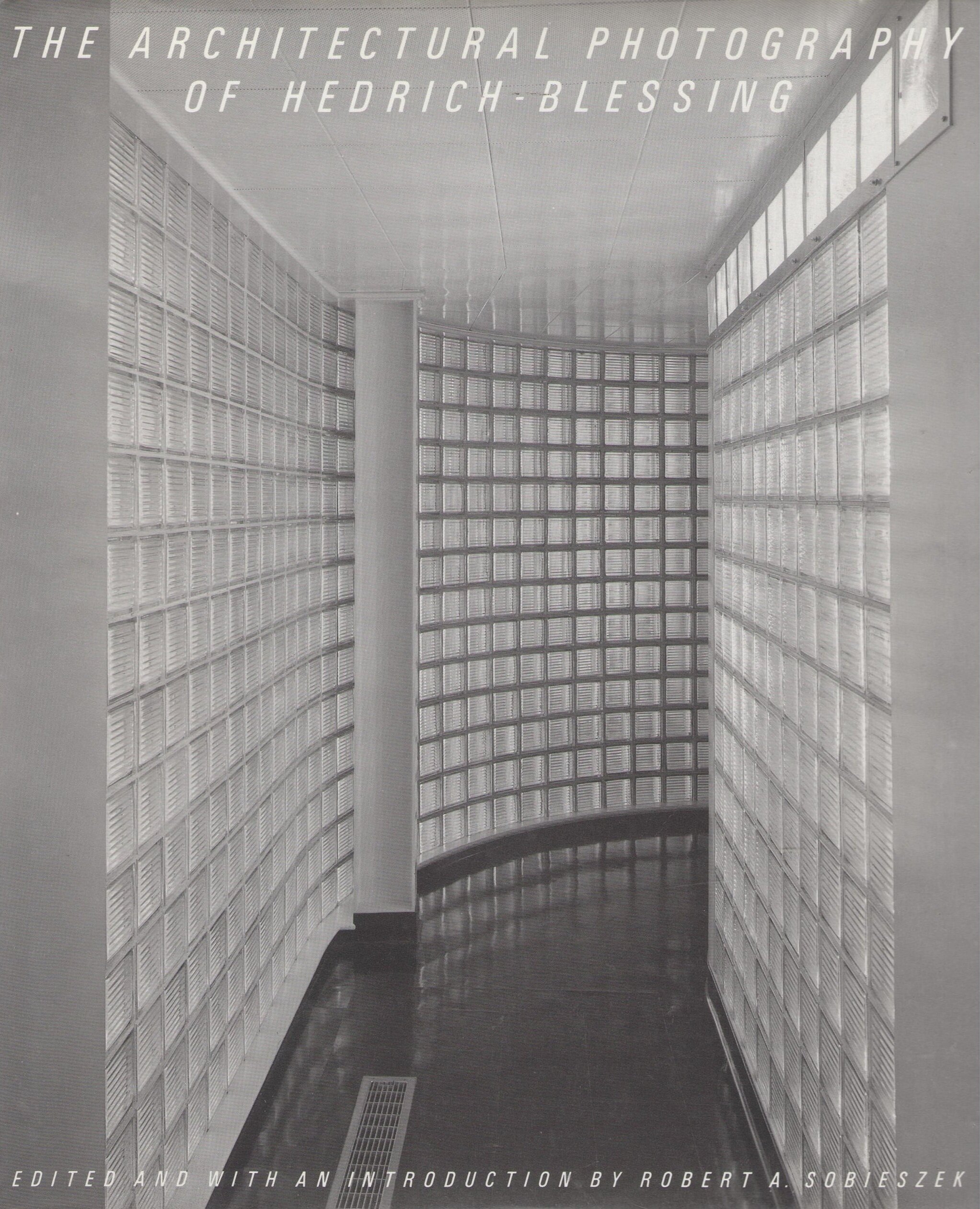Mies van der Rohe’s Barcelona Pavilion—one of THE key icons and exemplars of Modern Architecture—was built for a 1929 international exposition in Spain. It lasted only briefly, and—for decades thereafter—it was only known via its floor famous plan, a detail drawing of a column, and a handful of photographs (of which this view is the one most repeatedly reproduced.)
Mies died in 1969, and—nearly two decades after he had passed—a reconstruction of the Barcelona Pavilion was completed on the same site as the original. It has provided interesting experiences for architects (who never had a chance to visit the short-lived original)—but whether it should ever have been re-built remains a question within the architectural community.
"Never demolish, never remove or replace, always add, transform, and reuse!"
"Demolishing is a decision of easiness and short term. It is a waste of many things—a waste of energy, a waste of material, and a waste of history. Moreover, it has a very negative social impact. For us, it is an act of violence."
— Anne Lacaton and Jean-Philippe Vassal, winners of the 2021 Pritzker Prize in Architecture
A CASE THAT RAISES QUESTIONS
The Barcelona Pavilion, designed by Mies van der Rohe, was built for an exposition in 1929—a “world’s fair” wherein 20 countries participated, and in which there were also exhibits on industry, science, art, history, crafts, science, and agriculture. The fair lasted for less than a year, and the structure which represented Germany—the Barcelona Pavilion—was demolished along with the rest of the fair’s buildings (as is usually done with such fairs).
The Barcelona Pavilion’s “cruciform column”: this plan-detail of it was one of the few original Mies drawings available—and has been the focus of attention for nearly a century.
After Paul Rudolph visited the Barcelona Pavilion, he made a series of fascinating analytical drawings—one of which is shown above—and all of which you can see here (where you can also read Rudolph’s thoughts about his moving experience of the building.)
Mies’ design became famous: an “icon”—an ontological distillation of a key thrust of architectural Modernism. Mies’ building lasted for only about 8 months, yet it continues to penetrate and have hegemony over architectural imaginations to this day. It did that via a handful of photographs and a couple of drawings—and it’s a testament to the power of the Mies’ concept that the Barcelona Pavilion has remained relevant for nearly a century, even on such thin evidence.
Later in Mies’ life, he was asked about rebuilding the Barcelona Pavilion, and he’s reported to have thought that it wasn’t a bad idea, and—-as the original construction drawings had been lost—he mentioned that his office could cooperate by making drawings for it. But, during Mies life (1886-1969), nothing came of the project.
In the mid-1980’s that changed: between 1983 and 1986 the building had been permanently rebuilt—and on the same site it had originally stood.
Very few of the people who’d be the most interested in the building—the architectural community—had a chance to visit the Barcelona Pavilion when it was briefly extant (and obviously none after its destruction). So the rebuilding has been celebrated, as it has allowed one to finally experience, in person, what they’d read about, studied, obsessed over, and dreamt of. [Paul Rudolph made a visit, which he found highly moving—and which you can read all about, here.]
Even though the reappearance, “in the flesh”, of the Barcelona Pavilion has benefits, its rebuilding has also been not without controversy—and it has brought forth serious questions:
Could a truly accurate rebuilding be done without the original architect’s direct involvement? [Which was clearly not possible in this case, as Mies had passed years before the rebuilding project even started.]
Even if Mies had been involved, would he have made changes in the a rebuilt design?—and how would that affect its authenticity. [Paul Rudolph observed that many things he saw at the site were not architecturally “resolved”—and that, Rudolph thought, was part of its magic. That imperfection may be “par for the course” with a rapidly planned and constructed, temporary exposition building—-but the temptation to “fix” such things, later, might have been too much for anyone (especially Mies) to resist.]
An important part of the experience of the Barcelona Pavilion was the effect caused by the materials used: slabs of natural stone—including some personally selected by Mies. These had been destroyed or dispersed, when the building was demolished in 1930. [How could one know that the newly chosen materials truly matched the originals in tone, grain, color, and texture?]
How much documentation was actually available, in order to do an accurate rebuilding? [In this case, while valiant attempts were made to sift for all documents and archeological evidence, there was still a significant gap between whatever original information was found, and what had to be extrapolated.]
Are there things that are better left in the realm of the imagination, and which should not be materialized (even when we have the power to do so)? [Philip Johnson—THE long-time associate, expert, and evangelist for Mies—said of the rebuilding project: “The problem before us is should a dream be realized or not? We have made such a myth of that building. Shouldn’t it be left in the sacred vault of the memory bank?”]
These questions remain—-and they are pertinent today, as we are, more-and-more, presented with new building projects which, allegedly, intend to rebuild, recreate, reproduce, or restore something that has been lost.
One problem is that the the thinking and language around these questions has become elastic, slippery, and with elusive meaning or intent. There is a lack of rigor in preservation—-not in the professional field, per se (about which we have immense admiration—-more about that below), but in the way that claims of preservation have been made which seem questionable. Making the situation even more difficult is that all this exists in a troublesome (and troubling) larger cultural context…
A REALITY / TRUST DEFICIT
A chart from the Pew Research Center’s study of Public Trust in Government: 1958-2019 The overall downward trend, from 1964 to the present, is evident. [Note that the largest and steepest drop was in the wake of the mid-1970’s Watergate scandal.] Whether such mistrust is deserved (and how one might ever determine such a titanic question) is another issue—nevertheless, the general direction of public sentiment is quite clear.
At the end of the 20th century, a symposium was held in New York on the topic of “Authenticity”. Topics ranged from the ubiquity (and intense popularity) of un-authorized “knock-off” copies of fashion items (like Gucci handbags) -to- the legitimacy of sampling in music; and—perhaps to spur new thinking about the question of “realness”—the event’s organizers had arranged for a drag queen to be the day’s host. It’s no secret that what can (and cannot) be trusted to be real, to be authentic, seems to be increasingly fluid — i.e.: the ongoing excitement about developments products for virtual reality (and their increasing consumer availability); that polls show trust in government has been on a nearly 60-year downward trend; our present (and elongating) moment when business, schooling, and socializing is done via screens; and everybody seems to have their own (and mutually exclusive) set of “facts.”
In the context of this, is it any wonder that we’re sensitive to such questions as:
What’s real ?
What’s authentic ?
What’s “Original” (and what’s “Original Intent”) ?
What has integrity ?
And these questions of integrity, of what is original, of what is authentic—the kind of truthfulness that might be found in architecture —comes up starkly in the domain of architectural preservation.
Ayn Rand’s architect hero, Howard Roark (at right) at a moment-of-truth: considering whether to compromise on the integrity of his design.
INTEGRITY aND ARCHITECTURE
Perhaps you’ve come across a building (or part of a building) which has been newly constructed—and the sponsors claim that their project is historically renovated, or that it is an authentic recreation, or that it is true to the spirit of the original architect, or that it is rehabilitated to match the original construction (or they characterize the work with similar such language.)
Do such claims have a solid basis? Or are they part of the “Creeping Surrealism” noted earlier?
Clearly, there shouldn’t be blanket verdicts on this (and one must judge on a case-by-case basis) — But, these days, one could hardly be overcautious when considering such claims, for, as Ayn Rand put it so starkly:
“A building has integrity, just as a man and just as seldom."
And that integrity (or lack thereof) can apply to preservation projects—ones which claim to be done with care, and rigor. But there’s also good news: there is a body-of-knowledge—and a profession to apply it—where such rigor can be found.
PRESERVATION—a pROFESSIONAL APPROACH
Fortunately, there is a well-developed discipline of Preservation—by which we mean the field that is historically and scientifically rigorous, professionally ethical, and which has a well-developed set of supporting institutions. activities, and tools. Some of those include:
standards-setting organizations
schools
certifications
professional groups, conferences, and ways of identifying and honoring distinguished work in the field
journals
publications
databases
government and public engagement
For example: One can see the wealth of preservation knowledge that’s been developed by looking at its publications. We asked Barbara A. Campagna, FAIA, LEED AP BD+C—a leading professional in this field, with in-depth experience in preservation—about this. We asked for the names of some of the key journals of the field—ones in which the profession of preservation shares its growing body of information and practical wisdom—and she mentioned: the Association for Preservation Technology’s APT Bulletin, the Journal of the Society of Architectural Historians, and DOCOMOMO International’s DOCOMOMO Journal—all of which are peer reviewed.
PRESERVATION LANGUAGE FOR CLEAR THINKING
The profession has as worked-out an extensive vocabulary—terms which can help bring clarity to any proposed project.
For example: The National Parks Service refers to “Four Approaches to the Treatment of Historic Properties”—and offers a concise glossary of the key terms:
Preservation focuses on the maintenance and repair of existing historic materials and retention of a property's form as it has evolved over time.
Rehabilitation acknowledges the need to alter or add to a historic property to meet continuing or changing uses while retaining the property's historic character.
Restoration depicts a property at a particular period of time in its history, while removing evidence of other periods.
Reconstruction re-creates vanished or non-surviving portions of a property for interpretive purposes.
Each of the highlighted words above has their own separate set of standards (and clicking on them will bring you to the the relevant pages where that’s gone into.) The National Parks Service also offers training and an extensive set of publications which cover many areas, including general preservation strategy as well as in-depth technical information—and you can access them here.
But they is just one of numerous preservation organizations (both national and local) which also offer advice, data, and a great range of assistance—the National Trust for Historic Preservation being another major resource.
CASE STUDIES sHOWING A POSITIVE DIRECTION
There are several projects, within Rudolph’s oeuvre, where renovation was done with responsibility and care. Notable is that these were done well after Rudolph’s passing—so they show that it is possible to do such work (including bringing a building up to later standards) well, and still be loyal to the original architect’s vision.
HEALY GUEST HOUSE (THE “COOCOON” HOUSE)
The Healy Guest House (1950) in Sarasota, Florida, is a waterside vacation residence designed near the beginning of Paul Rudolph’s career. Known for its catenary roof, inventive structure, and fresh form, the design—combined with Rudolph’s virtuoso drawing technique—was to help initiate Rudolph’s fame as one of America’s most creative young architects. Much published and studied over the decades, the City of Sarasota has added it to its list of Locally Historically Designated Properties in 1985.
In 2018, the house was leased to the Sarasota Architecture Foundation. They did a number of important renovation projects at the house, and—according to David Zaccardelli, the SAF board member overseeing the process—they “. . . .replaced the front door; restored the louvers, stripping them to natural grain wood; painted the exterior; and restored the front and rear porch, including the originally designed metal bench on the porch overlooking Bayou Louise. We also repaired the driveway and walkway pavers and installed new screens.” Following the renovations, the SAF contracted a local interior designer to furnish the residence in period-appropriate 1950’s-style furniture—and then reopened it for public tours.
Paul Rudolph’s perspective rendering of the Healy Guest House—which shows its iconic catenary curve roof.
The guest house, a Florida vacation structure built for the Healy family, sits along the water in Sarasota.
JEWETT ARTS CENTER AT WELLESLEY COLLEGE
The Mary Cooper Jewett Arts Center (1955-1958) was a breakthrough for Rudolph: it was his first major non-residential project to get built (and indeed, his latter career would include numerous buildings for education.). A complex program had to be accommodated—but, just as important: Rudolph sought to design a Modern building that would be sympathetic with the Wellesley’s existing vintage buildings. Those had been done in a “Collegiate Gothic” mode—a traditional style which had been popular approach for the design of campuses. Rudolph had no interest in reproducing the exact forms and details of the older buildings, but he did seek to resonate with them—and so he used shapes, proportions, glazing, and structure in ways that would fit well into the existing campus.
After about a half-century of use, the building needed a variety of repairs, and the college commissioned a comprehensive study of its condition. Significant work was judged to be needed for the windows: Rudolph had framed the glazing in wood, and by the mid 2010’s the window assemblies were in need of replacement. Several options were considered, but the best one—rebuilding the windows to match Rudolph’s design, but using a hardier wood, and carefully integrating double-glazing—was seen to be too expensive for the available budget. In 2019, the Paul Rudolph Heritage Foundation participated in discussions about the renovation plans, and encouraged the preservation team to hold to Rudolph’s vision—and suggested a funding and scheduling approach that would allow the university to do the renovations correctly (and be able to afford to do so.)
Paul Rudolph’s Jewett Arts Center, at Wellesley College. To resonate with campus’ other buildings (which had been designed in the Collegiate Gothic style), the new building was detailed to include coupled columns, pointed skylights, modulated metal screening, and a carefully articulated wood-framed window system.
One of Paul Rudolph’s details of the building’s exterior. This is a plan-detail, showing a concrete column (In a 4-lobed shape, which evokes the campus’ vintage Gothic-style building details), and a corner of the wood-framed glazing system. When constructed, the building was single-glazed (which was standard for the time).
YALE ART & ARCHITECTURE BUILDING
Paul Rudolph’s most famous work, the Yale Art & Architecture Building (1958-1964, rededicated as “Rudolph Hall” in 2008) had—after a major fire, years of patchy repairs and partial/unsympathetic renovations, and four decades of hard use by students—fallen into sorry shape. Yale even considered demolishing it, but a variety of causes (including significant support from Sid. R. Bass) brought forth a respectful and comprehensive renovation. The work included a focus on major systems (HVAC, lighting) and materials (particularly the condition of the exterior concrete and the glazing): they were upgraded, brought up to code, fixed, and—most important as the guiding principle—done in a way that maintained the forms and spirit of Rudolph’s vision for the school.
Although Paul Rudolph is famous for his perspective drawings, he also sometimes chose other graphic forms—like axonometric or isometric projections (the latter of which is used here, in his drawing of the Yale building.)
Windows—their form, details, and framing—are a part of every architects palette—and Paul Rudolph varied how they were handed in his design at Yale. Here they’re shown the process of replacement during the renovation.
PRESERVATION: THE ONGOING CHALLENGE
Sometimes preservation is straightforward—but more often there are difficulties—technical, budgetary, and philosophical. The ancient Greek riddle of the Ship of Theseus provides a paradigmatic example of the latter:
That legendary hero, Theseus, upon finishing his adventures and long journey, returned to Athens by ship. Honoring him, the ship was kept in the harbor for hundreds of years—held sacred as a memorial to this great and most heroic warrior. But, over centuries, the ship’s parts needed to be replaced: first a few planks, then a mast, a beam, some decking…. By end of many years, every part of the ship had—piece-by-piece—been replaced. It happened slowly—so gradually that it had hardly been noticed—but what ultimately stood in the harbor was a ship made entirely of new materials, none of which had been present in Theseus’ time. So the questions arose: Could this really be considered Theseus’ ship? Did it have a claim on authenticity? The form of the ship was the same, and the replacements were done slowly, over long years—and each time with meticulous care and good faith—but was it the same ship?
Had Theseus’ ship been preserved? That’s the essence of the question—one that’s been puzzled over for two millennia. The model can applied to many things: How much of the human body can be replaced, and still be considered human (or the same person)? How much can the staff of a design firm turn-over, before the fundamental nature of the entity is lost? How many members of a group can be replaced, and it still be the “same” band (or sports team)?
And what about when preserving a buildings? How much can be changed, and still be an authentic work of the original architect?
These issues are pertinent to the legacy of Paul Rudolph!
How much of a Paul Rudolph building can be changed or replaced, and it still really be a Paul Rudolph design?
Can one demolish a Rudolph building and re-build it later (with all or substantially new materials)—and claim that it is still a real work of Paul Rudolph?
The Paul Rudolph Heritage Foundation is pledged to protecting Rudolph’s legacy—including a focus on preservation. We are alive to these questions—and we aspire to bring integrity, knowledge, and rigor into all the cases which come to our attention. WE ARE WATCHING.
WHAT YOU CAN DO
If you know of any Paul Rudolph buildings that might be threatened—please contact us at: office@paulrudolphheritagefoundation.org
If you are thinking of renovating or changing a Paul Rudolph design, please feel truly welcome to talk to us: we’ll be happy to share our knowledge and experience.
Stay up-to-date with bulletins about the latest developments—and to get them, please join our foundation’s mailing list. You’ll get all the updates, (as well as other Rudolph news.)—and you can sign-up at the bottom of this page.
The Ship of Theseus, a famous and ancient riddle (and philosophical problem) with ongoing relevance for preservation—including for Paul Rudolph buildings.
IMAGE CREDITS
NOTES:
The Paul Rudolph Heritage Foundation (a non-profit 501(c)3 organization) gratefully thanks all the individuals and organizations whose images are used in this non-profit scholarly and educational project.
The credits are shown when known to us, and are to the best of our knowledge, but the origin and connected rights of many images (especially vintage photos and other vintage materials) are often difficult determine. In all cases the materials are used in-good faith in our non-profit scholarly and educational efforts. If any use, credits, or rights need to be amended or changed, please let us know.
When Wikimedia Commons links are provided, they are linked to the information page for that particular image. Information about the rights to use each of those images, as well as technical information on the images, can be found on those individual pages.
CREDITS, FROM TOP-TO-BOTTOM, AND LEFT-TO-RIGHT:
Barcelona Pavilion, 1929: vintage photo; Barcelona Pavilion, rebuilt in the 1980’s: Ashley Pomeroy via Wikimedia Commons; Mies’ Barcelona Pavilion cruciform column detail: vintage drawing; Paul Rudolph analytical drawing of the Barcelona Pavilion: © The Estate of Paul Rudolph, The Paul Rudolph Heritage Foundation; Chart of trust in government: Pew Research Center; Drawing of Healy Guest House: © The Estate of Paul Rudolph, The Paul Rudolph Heritage Foundation; Photograph of Healy Guest House: courtesy of the Sarasota Architectural Foundation; Photograph of Jewett Arts Center: © The Estate of Paul Rudolph, The Paul Rudolph Heritage Foundation; Detail of column and glazing system at Jewett Arts Center: © The Estate of Paul Rudolph, The Paul Rudolph Heritage Foundation; Isometric drawing of the Yale Art & Architecture Building: © The Estate of Paul Rudolph, The Paul Rudolph Heritage Foundation; Photograph of glazing renovation at the Yale Art & Architecture Building: Hoffmann Architects, Inc., via Wikimedia Commons; Mosaic of ancient Greek ship: Dennis Jarvis, via Wikimedia Commons





![A chart from the Pew Research Center’s study of Public Trust in Government: 1958-2019 The overall downward trend, from 1964 to the present, is evident. [Note that the largest and steepest drop was in the wake of the mid-1970’s Watergate scandal.] Wh…](https://images.squarespace-cdn.com/content/v1/5a75ee0949fc2bc37b3ffb97/1616438220772-C9X7PWXIHIW0L7MK9ZX1/trust%2Bin%2Bgovt.jpg)




















































































































































































































































